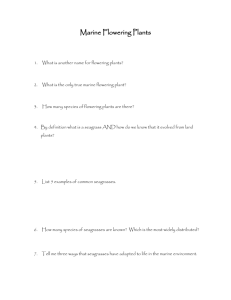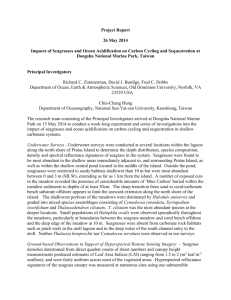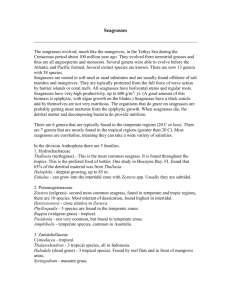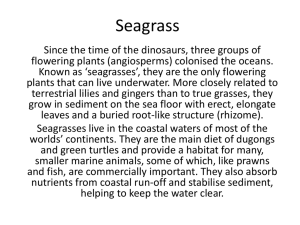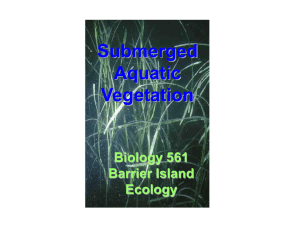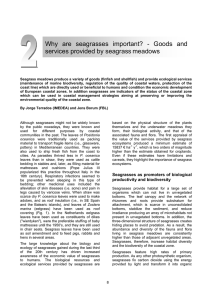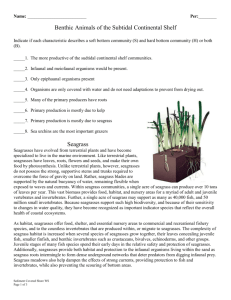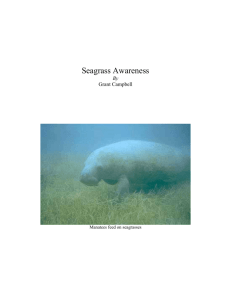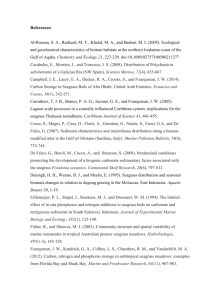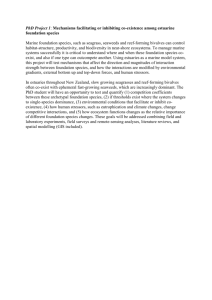Seagrasses - Perth Beachcombers Education Kit
advertisement
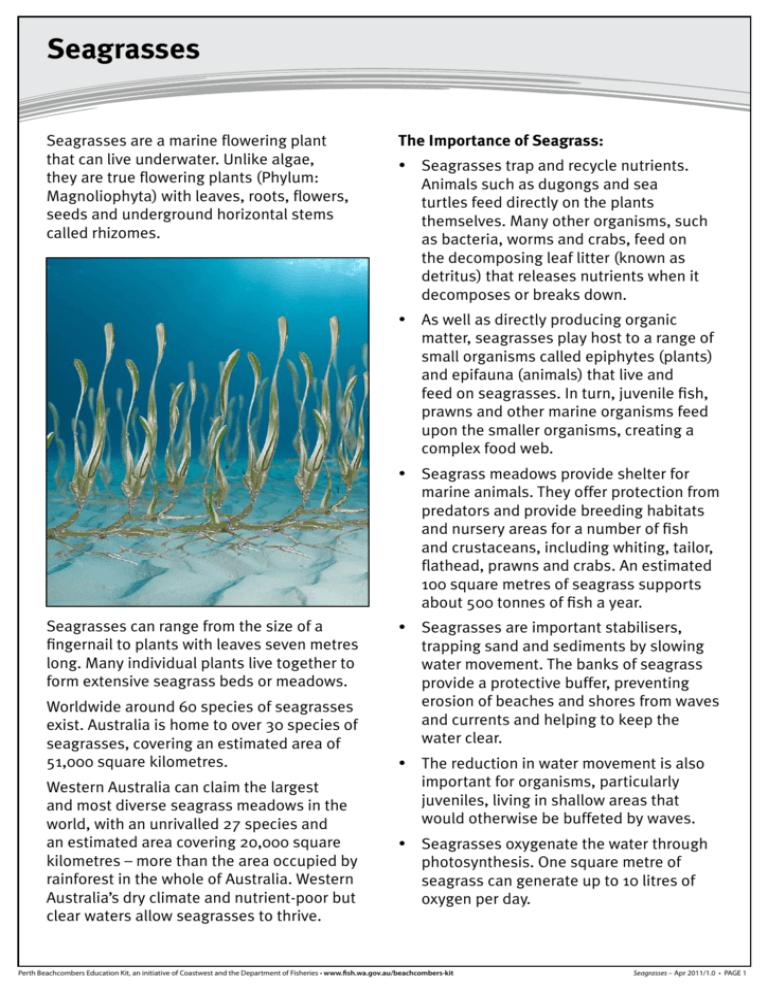
Seagrasses Seagrasses are a marine flowering plant that can live underwater. Unlike algae, they are true flowering plants (Phylum: Magnoliophyta) with leaves, roots, flowers, seeds and underground horizontal stems called rhizomes. The Importance of Seagrass: • Seagrasses trap and recycle nutrients. Animals such as dugongs and sea turtles feed directly on the plants themselves. Many other organisms, such as bacteria, worms and crabs, feed on the decomposing leaf litter (known as detritus) that releases nutrients when it decomposes or breaks down. • As well as directly producing organic matter, seagrasses play host to a range of small organisms called epiphytes (plants) and epifauna (animals) that live and feed on seagrasses. In turn, juvenile fish, prawns and other marine organisms feed upon the smaller organisms, creating a complex food web. • Seagrass meadows provide shelter for marine animals. They offer protection from predators and provide breeding habitats and nursery areas for a number of fish and crustaceans, including whiting, tailor, flathead, prawns and crabs. An estimated 100 square metres of seagrass supports about 500 tonnes of fish a year. Seagrasses can range from the size of a fingernail to plants with leaves seven metres long. Many individual plants live together to form extensive seagrass beds or meadows. Worldwide around 60 species of seagrasses exist. Australia is home to over 30 species of seagrasses, covering an estimated area of 51,000 square kilometres. Western Australia can claim the largest and most diverse seagrass meadows in the world, with an unrivalled 27 species and an estimated area covering 20,000 square kilometres – more than the area occupied by rainforest in the whole of Australia. Western Australia’s dry climate and nutrient-poor but clear waters allow seagrasses to thrive. • Seagrasses are important stabilisers, trapping sand and sediments by slowing water movement. The banks of seagrass provide a protective buffer, preventing erosion of beaches and shores from waves and currents and helping to keep the water clear. • The reduction in water movement is also important for organisms, particularly juveniles, living in shallow areas that would otherwise be buffeted by waves. • Seagrasses oxygenate the water through photosynthesis. One square metre of seagrass can generate up to 10 litres of oxygen per day. Perth Beachcombers Education Kit, an initiative of Coastwest and the Department of Fisheries • www.fish.wa.gov.au/beachcombers-kit Seagrasses – Apr 2011/1.0 • PAGE 1 Seagrasses continued... Significance of seagrass to marine life: • Western rock lobster forage in seagrass meadows close to the reefs in which they shelter. • Blue swimmer crabs forage on organisms living in and amongst seagrasses in coastal waters and estuaries. • Juvenile King George whiting use seagrass beds as nursery areas before moving to offshore reefs to begin their adult life. • Dugongs can consume up to 40 kilograms of seagrass per day. • Many species of juvenile prawns are highly dependant on seagrasses for food and shelter. Threats to seagrasses include: • Eutrophication. Excess nutrients cause either microalgae blooms or excessive growth of epiphytes on the leaves of seagrasses, which reduces the amount of light received for photosynthesis. • Turbidity and sedimentation. If not properly managed, factors such as agriculture and vegetation clearing in catchment areas, coastal and marine developments, and dredging can cause sand and silt to enter seagrass meadows. Increased turbidity or cloudiness of the water reduces light penetration affecting photosynthesis, while a build up of sediments will bury seagrasses. • Water pollution. Stormwater run-off, oil spills, herbicides and pesticides, discharge and other wastes can put large areas of seagrasses at risk. • Boating impacts. Damage to seagrass meadows by boat propellers, anchors, anchor chains and moorings is also common. The anchor from a large vessel can destroy an area of seagrass the size of a football field. • Natural causes. Storms or cyclones large enough to tear up and smother seagrass meadows can occasionally arise. Perth Beachcombers Education Kit, an initiative of Coastwest and the Department of Fisheries • www.fish.wa.gov.au/beachcombers-kit Seagrasses – Apr 2011/1.0 • PAGE 2
